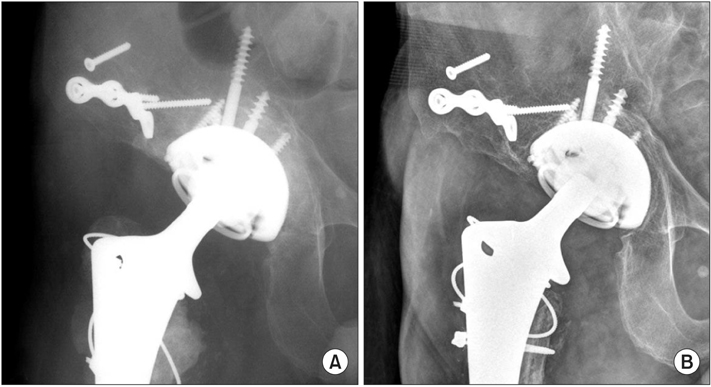J Korean Orthop Assoc.
2016 Aug;51(4):281-286. 10.4055/jkoa.2016.51.4.281.
Revision Total Hip Arthroplasty with Constrained Liner in Patients with Abductor Insufficiency
- Affiliations
-
- 1Department of Orthopedic Surgery, Keimyung University School of Medicine, Daegu, Korea. oslee@dsmc.or.kr
- KMID: 2348633
- DOI: http://doi.org/10.4055/jkoa.2016.51.4.281
Abstract
- PURPOSE
The purpose of this study was to evaluate clinical and radiographic results of revision total hip arthroplasty with constrained liner in patients with abductor insufficiency.
MATERIALS AND METHODS
In this study, 30 patients treated with constrained liner during revision total hip arthroplasty due to abductor insufficiency were evaluated after minimum 2-year follow-up. There were 14 men and 16 women and the mean follow-up period was 4.6 years. Re-dislocation and aseptic loosening of the implant were defined as a failure of the constrained liner. Harris hip score and ambulatory function were evaluated as a clinical parameter and osteolysis, aseptic loosening of the implant and other complications were evaluated as a radiologic parameter.
RESULTS
During the follow-up period, there were 4 cases (13.3%) of constrained liner failure including two cases of re-dislocation and two cases of acetabular cup aseptic loosening. The average Harris hip score was improved from 38.3 points preoperatively to 73.4 points at last follow up. At the final follow-up, there were 20 cases (66.7%) of improvement in ambulatory function. There was 1 case of infection and 1 case of periprosthetic fracture.
CONCLUSION
Use of a constrained liner during revision total hip arthroplasty showed satisfactory results for prevention of re-dislocation in patients with abductor insufficiency. However longer term studies on loosening of implants are needed.
MeSH Terms
Figure
Reference
-
1. Kim BS, Yoon HK, Han SH, Kim JH. The short term experiences of constrained acetabular component for unstable THA. Hip Pelvis. 2004; 16:392–397.2. Woo RY, Morrey BF. Dislocations after total hip arthroplasty. J Bone Joint Surg Am. 1982; 64:1295–1306.
Article3. Fricka KB, Marshall A, Paprosky WG. Constrained liners in revision total hip arthroplasty: an overuse syndrome: in the affirmative. J Arthroplasty. 2006; 21:4 Suppl 1. 121–125.4. Bozic KJ, Kurtz SM, Lau E, Ong K, Vail TP, Berry DJ. The epidemiology of revision total hip arthroplasty in the United States. J Bone Joint Surg Am. 2009; 91:128–133.
Article5. Sikes CV, Lai LP, Schreiber M, Mont MA, Jinnah RH, Seyler TM. Instability after total hip arthroplasty: treatment with large femoral heads vs constrained liners. J Arthroplasty. 2008; 23:7 Suppl. 59–63.6. Wetters NG, Murray TG, Moric M, Sporer SM, Paprosky WG, Della Valle CJ. Risk factors for dislocation after revision total hip arthroplasty. Clin Orthop Relat Res. 2013; 471:410–416.
Article7. Alberton GM, High WA, Morrey BF. Dislocation after revision total hip arthroplasty: an analysis of risk factors and treatment options. J Bone Joint Surg Am. 2002; 84:1788–1792.8. Berry DJ, von Knoch M, Schleck CD, Harmsen WS. The cumulative long-term risk of dislocation after primary Charnley total hip arthroplasty. J Bone Joint Surg Am. 2004; 86-A:9–14.
Article9. Coventry MB. Late dislocations in patients with Charnley total hip arthroplasty. J Bone Joint Surg Am. 1985; 67:832–841.
Article10. Fraser GA, Wroblewski BM. Revision of the Charnley low-friction arthroplasty for recurrent or irreducible dislocation. J Bone Joint Surg Br. 1981; 63B:552–555.
Article11. von Knoch M, Berry DJ, Harmsen WS, Morrey BF. Late dislocation after total hip arthroplasty. J Bone Joint Surg Am. 2002; 84-A:1949–1953.
Article12. Yun AG, Padgett D, Pellicci P, Dorr LD. Constrained acetabular liners: mechanisms of failure. J Arthroplasty. 2005; 20:536–541.
Article13. Goetz DD, Capello WN, Callaghan JJ, Brown TD, Johnston RC. Salvage of a recurrently dislocating total hip prosthesis with use of a constrained acetabular component. A retrospective analysis of fifty-six cases. J Bone Joint Surg Am. 1998; 80:502–509.
Article14. Goetz DD, Capello WN, Callaghan JJ, Brown TD, Johnston RC. Salvage of total hip instability with a constrained acetabular component. Clin Orthop Relat Res. 1998; 355:171–181.
Article15. Kaper BP, Bernini PM. Failure of a constrained acetabular prosthesis of a total hip arthroplasty. A report of four cases. J Bone Joint Surg Am. 1998; 80:561–565.
Article16. Goetz DD, Bremner BR, Callaghan JJ, Capello WN, Johnston RC. Salvage of a recurrently dislocating total hip prosthesis with use of a constrained acetabular component. A concise follow-up of a previous report. J Bone Joint Surg Am. 2004; 86-A:2419–2423.
Article17. Koval KJ, Skovron ML, Aharonoff GB, Meadows SE, Zuckerman JD. Ambulatory ability after hip fracture. A prospective study in geriatric patients. Clin Orthop Relat Res. 1995; (310):150–159.18. Padgett DE, Warashina H. The unstable total hip replacement. Clin Orthop Relat Res. 2004; 420:72–79.
Article19. Lachiewicz PF, Kelley SS. The use of constrained components in total hip arthroplasty. J Am Acad Orthop Surg. 2002; 10:233–238.
Article
- Full Text Links
- Actions
-
Cited
- CITED
-
- Close
- Share
- Similar articles
-
- Reducing Dislocations of Antibiotic Hip Spacers via Hybrid Cement-screw Constrained Liner Fixation: A Case Series
- Failure of a Metal Femoral Head after Revision Total Hip Arthroplasty for a Ceramic Liner Fracture
- Abductor Reconstruction with Gluteus Maximus Transfer in Primary Abductor Deficiency during Total Hip Arthroplasty
- Ceramic Head Fracture in Ceramic-on-Polyethylene Total Hip Arthroplasty
- Dissociation of Sandwich Ceramic Liner: A Case Report




